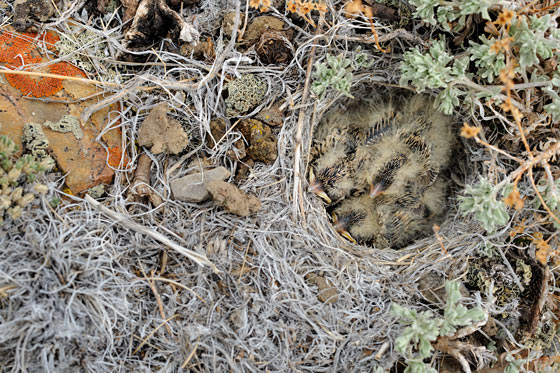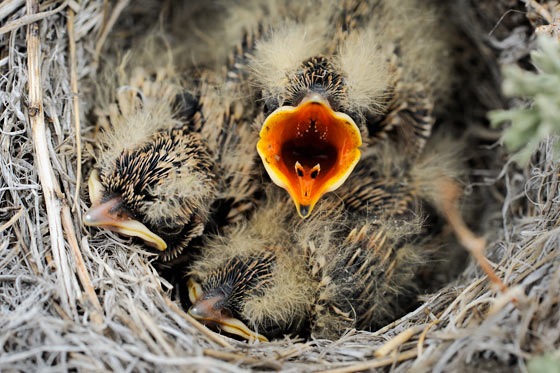Hatchlings at 12,000 feet with the ZF 50/2
I was strolling along at 12,000' in the White Mountains a few weeks ago in May, enjoying the intermittent snowflakes, when I was startled by a sudden flash of orange. A good thing too, as I might have stepped right on this clutch of hatchlings, which are really hard to see, even when looking straight at them. This is just one of many very enjoyable details I’ve come across in the White Mountains.
The larger and more aggressive chick must have heard enough noise to figure that it was food arriving, and indeed each click of the shutter elicited another gaping mouth. I stayed 30 seconds or so, not wanting to scare away Mama Bird, who (my theory goes) was away collecting accumulated bugs and insects from the remaining snowfields.
I shot this with the Zeiss ZF 50mm f/2 Makro-Planar (about $1033 at B&H). I like its field of view on full-frame, and It’s so versatile for walk-around shooting. Image quality ranks up there with the very best 50mm lenses, while offering 1:2 macro capability. With no focus shift like f/1.4 designs, its an easy-shooting lens.
 Unknown bird species hatchlings
Unknown bird species hatchlingsNikon D3x + Zeiss ZF 50/2 Makro-Planar
The interior markings are really striking. This must be nature’s way of making it easy for Mama Bird to figure out where the bugs go, or maybe to startle big animals with cameras.

The big one is on top and eats first
Nikon D3x + Zeiss ZF 50/2 Makro-Planar
UPDATE
After posting this, I was contacted by Professor of Biology Mark Chappell at the University of California, Riverside with some interesting information. I did observe an adult in the vicinity, but it stayed at too great a distance for me to observe details. In that area, there are no trees or brush, just open ground.
I've done quite a bit of research at the Barcroft Lab in the White Mountains over the past few decades (on birds, deer mice, other rodents, and insects) and know the place fairly well. Your nest is very probably that of a horned lark. Looks like it is on the ground and more or less out in the open (typical for this species), and although the chicks are not quite into fledgling plumage, they look rather 'larkish'. Did you notice an adult that looked like this in the vicinity?
It turns out that there has been quite a bit of study of how adult birds and offspring go about the business of getting food. You are correct that the bright mouth is a signal to the parents. In at least one species, the color is largely due to surface capillaries engorged with blood; interestingly, if the chick has a full stomach, blood is diverted to the digestive tract and hence the mouth isn't as brightly colored. This is an 'honest signal' of satiety and helps prevent the chick from 'cheating' (begging for more food than it needs). In some species, parents simply give food to whichever chick begs most aggressively; in other species parents share food equally among chicks (sometimes male and female parents differ in how they chose to provision).























